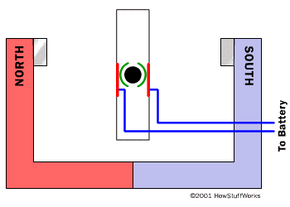Generators
If you've ever moved paper clips around with a magnet or killed time arranging metal shavings into a beard on a "Wooly Willy" toy, then you've dabbled in the basic principles behind even the most complicated electric generators. The magnetic field responsible for lining up all those little bits of metal into a proper Mohawk haircut is due to the movement of electrons. Move a magnet toward a paper clip and you'll force the electrons in the clip to move. Similarly, if you allow electrons to move through a metal wire, a magnetic field will form around the wire.
Thanks to Wooly Willy, we can see that there's a definite link between the phenomena of electricity and magnetism. A generator is simply a device that moves a magnet near a wire to create a steady flow of electrons. The action that forces this movement varies greatly, ranging from hand cranks and steam engines to nuclear fission, but the principle remains the same.
Advertisement
One simple way to think about a generator is to imagine it acting like a pump pushing water through a pipe. Only instead of pushing water, a generator uses a magnet to push electrons along. This is a slight oversimplification, but it paints a helpful picture of the properties at work in a generator. A water pump moves a certain number of water molecules and applies a certain amount of pressure to them. In the same way, the magnet in a generator pushes a certain number of electrons along and applies a certain amount of "pressure" to the electrons.
In an electrical circuit, the number of electrons in motion is called the amperage or current, and it's measured in amps. The "pressure" pushing the electrons along is called the voltage and is measured in volts. For instance, a generator spinning at 1,000 rotations per minute might produce 1 amp at 6 volts. The 1 amp is the number of electrons moving (1 amp physically means that 6.24 x 1018 electrons move through a wire every second), and the voltage is the amount of pressure behind those electrons.
Generators form the heart of a modern power station. In the next section, we'll take a look at how one of these stations works.
